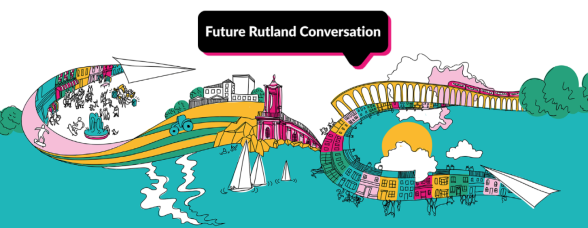Planning for Rutland’s Future - Issues and Options Consultation
2. Vision and Objectives
2.1 Vision
A key element in plan making is to establish a clear vision for the future and to set out objectives for delivering that vision during the plan period. This establishes the framework upon which the policies and proposals of the plan are built. The vision should reflect the Council's corporate vision and the Local Plan itself should be a delivery mechanism for the land-use elements of key strategic documents and corporate policy.
The Council is committed to developing a long-term vision for Rutland. Rutland County Council started the "Future Rutland" Conversation in 2021 to find out what really matters to local people and for them to help create the vision. The Council intends to use the vision to inform its long-term plans and policies with the aim to make the Future Rutland Vision central to every plan and big decision that is made in the County.

The vision approved by Council in March 2022 can be found on the Council's website.
This shared vision provides a set of long-term goals and aspirations based on the things that local people have said are most important: Rutland's character, its homeliness and community spirit, peace and well-being, nature, wildlife, rurality and the freedom to enjoy life.
- The Vision is split into four sections that cover all aspects of life in Rutland:
- A special place: Sustaining a vibrant rural county that harnesses the enterprise of its businesses, the ambition and creativity of its residents, and the passion of its local communities.
- Sustainable lives: Living sustainably and combatting the climate crisis through the power of choice, the removal of barriers, and real collective action.
- Healthy and well: Promoting health, happiness and well-being for people of all ages and backgrounds.
- A county for everyone: Celebrating diversity and ensuring everyone has the opportunity to live well, be heard and overcome any challenges they may face.
This Vision is not meant to be a detailed plan. The Local Plan vision should therefore draw on the Council's corporate plan and the Future Rutland Vision, although it will need to be adapted to correspond with the land use focus of the Local Plan. For example, the vision is not specific about the scale and location for future growth – this will be a matter for the Local Plan to determine. A proposed vision and objectives of the new Local Plan will be developed alongside consideration of the key issues and options for the new Local Plan.
The Local Plan can only seek to deliver the land-use elements of the Vision.
Please indicate which option you think should be used as the basis for preparing the Local Plan:
Option A: The Future Rutland Vision should be used as the basis of preparing the Local Plan bearing in mind that it will be for the Local Plan to establish a sustainable strategy for the scale and location for future growth and development.
Option B: Create a new vision specifically for the Local Plan and the plan period it will cover.
2.2 Objectives
Draft Proposed Strategic Objectives
Strategic Objective 1
Ensuring new development takes a proactive approach to carbon reduction and that environments and communities in Rutland are adaptable and resilient to climate change, including managing flood risks
Strategic Objective 2
Delivering sustainable development by determining an appropriate level and location of housing growth in Rutland, sited in locations where people can access jobs and services, and in delivering wider social and economic outcomes, taking account of environmental considerations
Strategic Objective 3
Meeting Rutland's identified current and future diverse housing needs, including the affordability of housing, through the provision of high-quality new homes
Strategic Objective 4
Supporting business investment and job creation in ways which are compatible with environmental considerations in order to maintain a prosperous and resilient economy in Rutland
Strategic Objective 5
Enabling Rutland's market towns, and their centres in particular, to be places for economic and cultural activity with good access to services; seeking to sustain a network of larger villages that serve local needs; and enabling the viability and sustainability of smaller villages and countryside – in ways which protect the County's heritage, character and identity
Strategic Objective 6
Supporting all communities across the County to make them safer, more resilient to change and enhance community cohesion
Strategic Objective 7
Encouraging new development to deliver a high standard of design that reflects local character, contributes to local distinctiveness, contributing to cleaner, greener and safer places
Strategic Objective 8
Ensuring new development and open spaces support health and wellbeing for all, reduce health inequalities and encourage active and healthy lifestyles
Strategic Objective 9
Protecting and enhancing Rutland's varied and high-quality environment, including its natural landscapes, green infrastructure and biodiversity, as well as its rich historic built environment and cultural assets
Strategic Objective 10
Encouraging the effective and prudent use of previously developed land and natural resources, including the efficient use of land and buildings and the use of sustainable construction techniques within new developments, as well as providing for waste management and disposal
Strategic Objective 11
Ensuring a steady and adequate supply of minerals to meet national, regional and local needs whilst taking account of impacts on environments and local communities
Strategic Objective 12
Ensuring development is supported by essential infrastructure and services (most notably: roads, schools, health facilities and utility provision) and promotes safe movement and more sustainable modes of travel by enhancing greener travel networks for walking, cycling and public transport
Question 2 Local Plan Strategic Objectives
Do you agree with these proposed objectives for the Local Plan Review?
Question 3
Please let us have additional suggestions you may have.
2.3 Priorities and Development Viability
In setting the priorities and objectives underpinning the Local Plan, the Council must consider the potential impacts these may have in terms of the financial costs placed on new development. There is a risk if expectations and policy requirements are too high, that development may not be viable. The Local Plan policies should be clear so that developers do not pay too much for a piece of land and then calculate that they cannot afford to meet policy requirements. If the value generated by a development is less than the cost of developing it, then it is likely that development will not take place. A careful balance needs to be struck in this respect to ensure requirements are at a level that is viable for development to go ahead. The Local Plan will therefore be subject to a Viability Appraisal which measures the costs of the various policy requirements for planned growth balanced against essential costs and the factors of value of development.
Planning policy requirements can relate to: the Community Infrastructure Levy to contribute to essential infrastructure to support development, e.g. education, transport, health; Developer contributions towards open space/recreation; Affordable housing requirements; Addressing climate change crisis such as zero carbon aims, energy efficiency and the future homes standard; requirements to deliver high quality design – materials and features ; Accessible and Adaptable Homes; Supporting nature recovery – net gains for biodiversity. The local plan must be deliverable and viable to be found "sound" by the Planning Inspector. The conclusions of the Viability Appraisal may, therefore, effect the ability of the council to include higher standards and requirements set out in this Issues and Options paper.

Diagram: showing a balance with essential development costs/land value on one side balanced by the costs of planning policy requirements
2.4 Deciding the Plan Period
The current Local Plan, adopted in 2011, covers the period 2006 -2026. The Council will need to decide what time period the new Local Plan should address.
The new Local Plan must cover a minimum period of 15 years following adoption and should identify the scale of development and the key locations to meet this need during this plan period. The Council could decide to plan for a longer time frame if it considers it appropriate to do so. The timetable for production of the Local Plan sets out likely adoption of a new plan by 2025, and so based on this, the minimum plan period for the emerging Local Plan will need to be at least until 2040.
Paragraph 22 of the NPPF states "strategic policies should look ahead over a minimum 15-year period from adoption, to anticipate and respond to long-term requirements and opportunities, such as those arising from major improvements in infrastructure. Where larger scale developments such as new settlements or significant extensions to existing villages and towns form part of the strategy for the area, policies should be set within a vision that looks further ahead (at least 30 years), to take into account the likely timescale for delivery".
The longer time frame would need to be applied where most of the development arising from larger scale developments will be delivered well beyond the plan period, and where delivery of those developments extends 30 years or longer from the start of the plan period. In such cases the authority will need to ensure that their vision reflects the long-term nature of their strategy for the plan or those larger scale developments. It is not anticipated that such visions would require evidence in addition to that already produced to support the plan.
Based on these considerations, the Council is proposing that the plan period for the new Local Plan should be a minimum of 20 years from 2021 to 2041, to cover a level of contingency in the time taken to adopt the plan.

Diagram showing the time frame for the current adopted Development Plan alongside the period which the new Local Plan could cover.
Do you agree with the proposed 20-year plan period (2021-2041) for the Local Plan?
Question 4b
If you disagree, please suggest the timeframe you think the plan should cover
